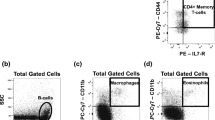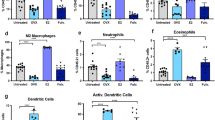Abstract
We have previously shown that the immunoregulatory function of prolactin may play a role in the progression of the mouse mammary preneoplastic hyperplastic alveolar nodule (HAN) line C4 to carcinoma. In this study we investigated the direct effect of prolactin on lymphocytes isolated from normal and C4-HAN-bearing mice. In addition, we tested the effect of ovariectomy on prolactin/lymphocyte interaction to see whether, as has been reported in rats [Mukherjee P., Hymer W. C. (1992) Prog Neuroendocrinol Immunol 5: 108; Viselli S. M. et al. (1991) Endocrinology 129: 983], removal of estrogen would enhance the response to prolactin in mice. Proliferation of splenocytes, lymph node cells and HAN-in-filtrating lymphocytes was stimulated by prolactin in a dose-responsive fashion. Ovariectomy did not alter this effect consistently. Cell-cycle analysis based on simultaneous staining of DNA and RNA revealed that prolactinstimulated lymphocytes progress through all phases of the cell cycle whereas anti-prolactin antiserum inhibits this stimulation. Two-color flow-cytometric analysis revealed the time-dependent induction of interleukin-2 (IL-2) receptor expression on both CD4+ and CD8+ cells by prolactin. Prolactin-treated lymphocytes also produced low yet detectable levels of bioactive IL-2 in a dose-and time-dependent fashion. Prolactin enhanced lymphocyte responsiveness to mitogens and showed a marked synergism at suboptimal concentrations. Pretreatment of splenocytes from HAN bearers with a high concentration of prolactin slightly enhanced natural killer (NK) activity; anti-prolactin antiserum reduced the NK lytic activity of poly(I)-poly(C)-activated splenocytes from HAN-bearing mice. Our results provide direct experimental evidence for the stimulatory effect of prolactin on lymphocyte function and IL-2-mediated lymphocyte proliferation and suggest a mechanism linking the endocrine system to immunomediated enhancement of HAN progression.
Similar content being viewed by others
References
Ader R, Felten DL, Cohen N (1990) Interactions between the brain and the immune system. Annu Rev Pharmacol Toxicol 30: 561
Ahmed SA, Penhale WJ, Talal N (1985) Sex hormones, immune responses, and autoimmune diseases. Am J Pathol 121: 531
Berczi I (1986) Immunoregulation by pituitary hormones In: Berczi I (ed.) Pituitary function and immunity. CRC Press, Boca Raton, Fla, p 227
Bernton EW, Meltzer M, Holaday JW (1988) Suppression of macrophage activation and T-lymphocyte function in hypoprolactinemic mice. Science 239: 401
Biswas R, Chattopadhyay U (1992) Altered prolactin response of the lymphocytes of tumor-bearing mice. Int J Cancer 50: 93
Blalock JE, Harbour-McMenamin D, Smith EM (1985) Peptide hormones shared by the neuroendocrine and immunologic systems. J Immunol 135: 858s
Callahan JE, Herman A, Kappler JW, Marrack P (1990) Stimulation of B10.BR T cells with superantigenic staphylococcal toxins. J Immunol 144: 2473
Clevenger CV, Russell DH, Appasamy PM, Prystowsky MR (1990) Regulation of interleukin 2-driven T-lymphocyte proliferation by prolactin. Proc Natl Acad Sci USA 87: 6460
Clevenger CV, Altmann SW, Prystowsky MB (1991) Requirement of nuclear prolactin for interleukin-2 stimulated proliferation of T lymphocytes. Science 253: 77
Darzynkiewicz Z (1990) Differential staining of DNA and RNA in intact cells and isolated cell nuclei with acridine orange. Methods Cell Biol 33: 285
DiMattia GE, Gellersen B, Bohnet HG, Friesen HG (1988) A human B-lymphoblastoid cell line proluces prolactin. Endocrinology 122: 2508
Dunn AJ (1989) Psychoneuroimmunology for the psychoneuroendocrinologist: a review of animal studies of nervous systemimmune system interactions. Psychoneuroendocrinology 14: 251
Gagnerault MC, Touraine P, Savino W, Kelly PA, Dardenne MJ (1993) Expression of prolactin receptors in murine lymphoid cells in normal and autoimmune situations. J Immunol. 150: 5673
Hartmann DP, Holaday JW, Bernton EW (1989) Inhibition of lymphocyte proliferation by antibodies to prolactin. FASEB J 3: 2194
Hiestand PC, Mekler P, Nordmann R, Grieder A, Permmongkol C (1986) Prolactin as a modulator of lymphocyte responsiveness provides a possible mechanism of action for cyclosporin. Proc Natl Acad Sci USA 83: 2599
Hiestand PC, Gale JM, Mekler P (1986) Soft immunosuppression by inhibition of prolactin release: synergism with cyclosporine in kidney allograft survival and in the localized graft-versus-host reaction. Transl Proc 28: 870
Ip MM, Shoemaker SF, Darcy KM (1992) Regulation of rat mammary epithelial cell proliferation by tumor necrosis factor α. Endocrinology 130: 2833
Jara LJ, Lavalle C, Fraga A, Gomez-Sanchez C, Silveira LH, Martinez-Osuna P, Germain BF, Espinoza LR (1991) Prolactin, immunoregulation, and autoimmune diseases. Semin Arthritis Rheum 20: 273
Karanth S, McCann SM (1991) Anterior pituitary hormone control by interleukin 2. Proc Natl Acad Sci USA 88: 2961
Matera L, Muccioli G, Cesano A, Bellussi G, Genazzani E (1988) Prolactin receptors on large granular lymphocytes: dual regulation by Cyclosporin A. Brain Behav Immun 2: 1
Maurer RA (1982) Estradiol regulates the transcription of the prolactin gene. J Biol Chem 257: 2133
Montgomery DW, LeFevre JA, Ulrich ED, Adamson CR, Zuko CF (1990) Identification of prolactin-like proteins synthesized by normal murine lymphocytes. Endocrinology 127: 2601
Mukherjce P, Hymer WC (1992) Heterogeneity of rat pituitary prolactin cells: relationships among location, hormone assay and estrous cycle stage. Prog Neuroendocrinol Immunol 5: 108
Mukherjce P, Mastro AM, Hymer WC (1990) Prolactin induction of interleukin-2 receptors on rat splenic lymphocytes. Endocrinology 126: 88
Nagy L, Berczi I, Wren GE, Asa SL, Kovacs K (1983) Immunomodulation by bromocriptine. Immunopharmacology 6: 231
Ohnami S, Eto S, Ohnami S, Soejima T, Nakata H (1987) Characterization of “big big prolactin” in serum and tumor extract in patients with PRL-secreting tumor. Endocrinol Jpn 34: 325
O'Neal KD, Schwarz LA, Yu-Lee L-Y (1991) Prolactin receptor gene expression in lymphoid cells. Mol Cell Endocrinol 82: 127
Pellegrini I, Lebrun J-J, Ali S, Kelly PA (1992) Expression of prolactin and its receptor in human lymphoid cells. Mol Endocrinol 6: 1023
Sabharwal P, Glaser R, Lafuse W, Varma S, Liu Q, Arkins S, Koojiman R, Kutz L, Kelly KW, Malarkey WB (1992) Prolactin synthesized and secreted by human peripheral blood mononuclear cells: an autocrine growth factor for lymphoproliferation. Proc Natl Acad Sci USA 89: 7713
Scarborough DE (1990) Cytokine modulation of pituitary hormone secretion. Proc NY Acad Sci USA 594: 169
Schuurs AHWM, Verheul HAM (1990) Effects of gender and sex steroids on the immune response. J Steroid Biochm 35: 157
Serepanti I, Meco D, Morrone S, Gulino A, Mathieson BJ, Frati L (1991) In vivo modulation of the distribution of thymocyte subsets: effects of estrogen on the expression of different T cell receptor Vß gene family in CD4-, CD8-thymocytes. Cell Immunol 134: 414
Steel JH, Hamid Q, Van Noorden S, Jones P, Denny P, Burrin J, Legon S, Bloom SR, Polak JM (1988) Combined use of in situ hybridisation and immunochemistry for the investigation of prolactin gene expression in immature, pubertal, pregnant, lactating and ovariectomised rats. Histochemistry 89: 75
Tsai SJ, Loeffler D, Heppner GH (1992) Associated effects of bromocriptine on neoplastic progression of mouse mammary preneoplastic hyperplastic alevolar nodule (HAN) line C4 and on HAN-infiltrating and splenic lymphocyte function. Cancer Res 52: 2209
Tsai S-CJ, Soule H, Heppner GH (1993) Dichotomous effects of cytokines on the growth modulation of parental and oncogene transfected MCF-10A cell lines. Proc Am Assoc Cancer Res 34: 97
Viselli SM, Stanek EM, Mukherjee P, Hymer WC, Mastro AM (1991) Prolactin-induced mitogenesis of lymphocytes from ovariectomized rats. Endocrinology 129: 983
Wei W-Z, Fulton AM, Winkelhanke J, Heppner GH (1989) Correlation of natural killer activity with tumorigenesis of a preneoplastic mouse mammary lesion. Cancer Res 49: 2709
Yamaguchi M, Koike K, Matsuzaki N, Yoshimoto Y, Taniguchi T, Miyake A, Tanizawa O (1991) The interferon family stimulates the secretions of prolactin and interleukin-6 by the pituitary gland in vitro. J Endocrinol Invest 14: 457
Author information
Authors and Affiliations
Rights and permissions
About this article
Cite this article
Jane Tsai, S.C., Heppner, G.H. Immunoendocrine mechanisms in mammary tumor progression: Direct prolactin modulation of peripheral and preneoplastic hyperplastic-alveolar-nodule-infiltrating lymphocytes. Cancer Immunol Immunother 39, 291–298 (1994). https://doi.org/10.1007/BF01519981
Received:
Accepted:
Issue Date:
DOI: https://doi.org/10.1007/BF01519981




